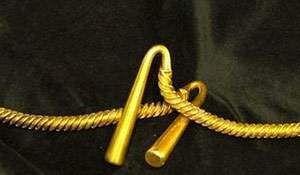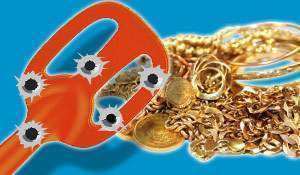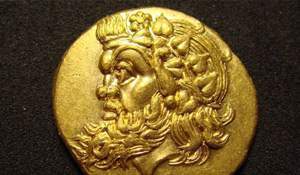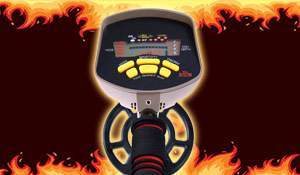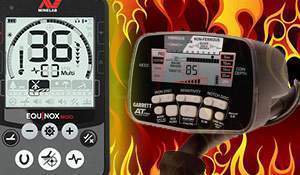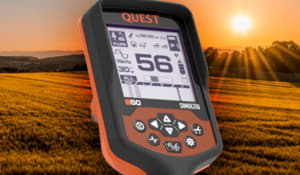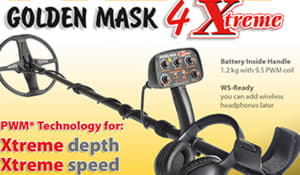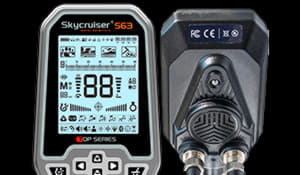1st Texas (USA)
- 1st Texas Titan 9000 • ground detector • 8 Mono
AKA (Russia)
- AKA Berkut-5 • ground detector • 10 DD
- AKA Intronik L • ground detector • 10 DD
- AKA Intronik STF • ground detector • 10 DD
- AKA Kondor-3 • ground detector • 10 DD
- AKA Kondor-7252 • ground detector • 10 DD
- AKA Kondor-7252M • ground detector • 10 DD
- AKA Piligrim-47 • ground detector • 10 DD
- AKA Piligrim-7246 • ground detector • 12 DD
- AKA Signum MFD HM • ground detector • HM Tech 10 DD
- AKA Signum MFT 7272M • ground detector • 10 DD
- AKA Signum SFT 7270 • ground detector • 10 DD
- AKA Sorex 7280 • ground detector • 10 DD
- AKA Sorex 7281 • ground detector • 10 DD
Bounty Hunter (USA)
- Bounty Hunter 1st Texas Pilot • ground detector • D-Tech 725
- Bounty Hunter Discovery 1100 • ground detector • 7 Mono
- Bounty Hunter Discovery 2200 • ground detector • 8 Mono
- Bounty Hunter Discovery 3300 • ground detector • 8 Mono
- Bounty Hunter Fast Tracker • ground detector • 7 Mono
- Bounty Hunter Gold • ground detector • 8
- Bounty Hunter Gold Digger • ground detector • 7 Mono
- Bounty Hunter HandyMan • ground detector • 6.5 Mono
- Bounty Hunter Junior • ground detector • 6.5 Mono
- Bounty Hunter Junior Target ID • ground detector • 6.5 Mono
- Bounty Hunter Land Ranger Pro • ground detector • 11 DD
- Bounty Hunter Lone Star • ground detector • 8 Mono
- Bounty Hunter Lone Star Pro • ground detector • 8 Mono
- Bounty Hunter Mach 1 • ground detector • 6 Mono
- Bounty Hunter Pioneer 501 • ground detector • 8 Mono
- Bounty Hunter Pioneer 503 • ground detector • 8 Mono
- Bounty Hunter Pioneer 505 • ground detector • 8 Mono
- Bounty Hunter Platinum • ground detector • 8
- Bounty Hunter Quick Draw 2 • ground detector • 8 Mono
- Bounty Hunter Quick Draw PRO • ground detector • 10 Mono
- Bounty Hunter Quick Silver • ground detector • 8 Mono
- Bounty Hunter Time Ranger Pro • ground detector • 11 DD
- Bounty Hunter Tracker 2 • ground detector • 7 Mono
- Bounty Hunter Tracker 4 • ground detector • 8 Mono
- Bounty Hunter Tracker Pro • ground detector • 7 Concentric
- Bounty Hunter VLF • ground detector • 7 Mono
Cobra (USA)
- Cobra Beach Magnet • ground and underwater detector • 10 Mono
- Cobra Wader Series • ground and underwater detector • 10 Mono
DeepTech (Bulgaria)
- DeepTech Vista Gold • ground detector • 12 DD Super Six
- DeepTech Vista Gold Gain • ground detector • 12 DD Super Six
- DeepTech Vista Mini • ground detector • 11 DD (Vista)
- DeepTech Vista Mini Max • ground detector • 6 DD
- DeepTech Vista Relic • ground detector • 12 DD Super Six
- DeepTech Vista RG 1000 v2 • ground detector • 12 DD Super Six
- DeepTech Vista RG 750 v2 • ground detector • 12 DD Super Six
- DeepTech Vista Smart • ground detector • 11 DD Pitbull
- DeepTech Vista Smart Plus • ground detector • 11 DD Pitbull
- DeepTech Vista Smart Plus PRO • ground detector • 11 DD Octagon
- DeepTech Vista Sprite • ground detector • 12 DD HP
- DeepTech Vista Warrior • ground detector • 12 DD HP
- DeepTech Vista X • ground detector • 11 DD Octagon
Detech (Bulgaria)
- Detech Chaser 14 kHz • ground detector • 9 ULTIMATE DD
- Detech Chaser 28 kHz • ground detector • 9 ULTIMATE DD
- Detech Chaser 4.8 kHz • ground detector • 9 ULTIMATE DD
- Detech EDS Gold Catcher • ground detector • 10 DD Round
- Detech EDS Plus 2 • ground detector • 12x12 SEF PRO
- Detech EDS Reacher • ground detector • 12x12 SEF PRO
- Detech EDS Winner 2 • ground detector • 12x12 SEF PRO
- Detech Relic Striker • ground detector • 18x15 SEF
Detector Pro (USA)
- Detector Pro Pirate • ground and underwater detector • 8 Mono
- Detector Pro Pirate Pro • ground and underwater detector • 8 Mono
- Detector Pro Underwater • ground and underwater detector • 8 Mono
- Detector Pro Wader • ground and underwater detector • 8 Mono
Deteknix (USA)
- Deteknix Quest Gold • ground and underwater detector • 9.5 DD
- Deteknix Quest PRO • ground and underwater detector • 11 DD
Fisher (USA)
- Fisher CZ-3D • ground and underwater detector • 8 (8COIL-7-CZ3)
- Fisher CZX • ground and underwater detector • 11 DD (?)
- Fisher F11 • ground detector • 7 Mono (7COIL-RE-F)
- Fisher F19 • ground detector • 6x10 DD
- Fisher F2 • ground detector • 8 (8COIL-7BLKF)
- Fisher F22 • ground detector • 9 Mono (9COIL-EE)
- Fisher F4 • ground detector • 11 DD Bi-Axial (11COIL-F4F)
- Fisher F44 • ground detector • 11 Mono (11COIL-EE)
- Fisher F5 • ground detector • 10 (10COIL-F5F)
- Fisher F55 • ground and underwater detector • 11 DD Bi-Axial (11COIL-F55)
- Fisher F70 • ground detector • 10 (10COIL-F70)
- Fisher F75 • ground detector • 11 DD Bi-Axial (11COIL-F75)
- Fisher F75 Plus • ground detector • 11 DD Bi-Axial (11COIL-F75)
- Fisher F80 • ground detector • 11 DD BiAxial (?)
- Fisher F85 • ground and underwater detector • 11 DD BiAxial (?)
- Fisher Gold Bug 2 • ground detector • 6.5 Elliptical
- Fisher Gold Bug DP • ground detector • 11 DD Bi-Axial (11COIL-GB)
- Fisher Gold Bug Pro • ground detector • 5 DD (5COIL-GBUG)
- Fisher Impulse AQ • ground and underwater detector • 12.5 AQ Mono
- Fisher Impulse AU • ground and underwater detector • 12.5 AQ Mono
- Fisher Mosca • ground and underwater detector • 11 DD (?)
- Fisher Pro-Arc • ground detector • 11 DD
- Fisher Pro-Tech • ground detector • 10 DD Elliptical
Garrett (USA)
- Garrett ACE 150 • ground detector • 6.5x9 ACE PROformance
- Garrett ACE 200 • ground detector • 6.5x9 ACE PROformance
- Garrett ACE 200i • ground detector • 6.5x9 ACE PROformance
- Garrett ACE 250 • ground detector • 6.5x9 ACE PROformance
- Garrett ACE 300 • ground detector • 7x10 ACE PROformance
- Garrett ACE 300i • ground detector • 7x10 ACE PROformance
- Garrett ACE 350 • ground detector • 8.5x11 ACE DD
- Garrett ACE 400 • ground detector • 8.5x11 ACE DD
- Garrett ACE 400i • ground detector • 8.5x11 ACE DD
- Garrett ACE Apex • ground detector • 6x11 Viper Multi-Flex DD
- Garrett AT Gold • ground and underwater detector • 5x8 DD PROformance
- Garrett AT MAX • ground and underwater detector • 8.5x11 PROformance DD
- Garrett AT MAX International • ground and underwater detector • 8.5x11 PROformance DD
- Garrett AT Pro • ground and underwater detector • 8.5x11 PROformance DD
- Garrett AT Pro International • ground and underwater detector • 8.5x11 PROformance DD
- Garrett ATX • ground and underwater detector • ATX 10x12 DD
- Garrett Axiom • ground detector • 13x11 DD Axiom
- Garrett Euro ACE • ground detector • 8.5x11 ACE DD
- Garrett Goldmaster 24K • ground detector • Whites 6x10 DD Goldmaster
- Garrett GTI 1500 • ground detector • 9.5 PROformance Imaging
- Garrett GTI 2500 • ground detector • 9.5 PROformance Imaging
- Garrett GTI 3500 • ground and underwater detector • 11 DD
- Garrett GTP 1350 • ground detector • 7x10 PROformance
- Garrett Scorpion Gold Stinger • ground detector • 5x10 Power DD
Golden Mask (Bulgaria)
- Golden Mask 1 • ground detector • 10.5 DD
- Golden Mask 1 Plus HF • ground detector • 10.5 DD
- Golden Mask 2 • ground detector • 10.5 DD
- Golden Mask 3 • ground detector • 10.5 DD
- Golden Mask 3 Plus Turbo • ground detector • 10.5 DD
- Golden Mask 4 • ground detector • 10.5 DD
- Golden Mask 4 Pro • ground detector • 10.5 DD
- Golden Mask 4WCL • ground detector • 13 Fighter S
- Golden Mask 4WD Pro • ground detector • 10.5 DD
- Golden Mask 5 • ground detector • 9 DD
- Golden Mask 5 Plus • ground detector • 9 DD
- Golden Mask 5 Plus SE • ground detector • 12 DD
- Golden Mask 5 Plus SE 15-30 kHz • ground detector • 12 DD
- Golden Mask 5 Plus SE 5-15 kHz • ground detector • 12 DD
- Golden Mask 6 • ground detector • 13 Fighter S
- Golden Mask 7 • ground detector • 13 Fighter S
- Golden Mask LP ZERO • ground detector • 9 DD
- Golden Mask NOS e200 • ground detector • 10.5 DD
- Golden Mask NOS e300 • ground detector • 10.5 DD
- Golden Mask ONE 15 • ground detector • 12 DD
- Golden Mask ONE 15 Black • ground detector • 13 Fighter S
- Golden Mask ONE 24 • ground detector • 9x10 DD
- Golden Mask ONE 8 • ground detector • 12 DD
- Golden Mask Thracian • ground detector • 12 DD
Ground EFX (USA)
- Ground EFX Cyclone MC1 • ground detector • 6.5 Mono
- Ground EFX Cyclone MC2 • ground detector • 6.5 Mono
- Ground EFX MX100 • ground detector • 11 DD
- Ground EFX MX100E • ground detector • 10 Mono
- Ground EFX MX200 • ground detector • 11 DD
- Ground EFX MX200E • ground detector • 10 Mono
- Ground EFX MX300 • ground detector • 11 DD
- Ground EFX MX400 • ground detector • 11 DD
- Ground EFX MX50 • ground detector • 8 Mono
- Ground EFX MX60 • ground detector • 10 Mono
Makro (Turkey)
- Makro CF77 • ground detector • 11 DD (C28)
- Makro Gold Kruzer • ground and underwater detector • 10x5.5 DD (GK26 DD)
- Makro Gold Racer • ground detector • 10x5.5 DD (GR26 DD)
- Makro Kruzer • ground and underwater detector • 11x7 DD (KR28 DD)
- Makro Multi Kruzer • ground and underwater detector • 11x7 DD (KR28 DD)
- Makro Racer • ground detector • 11x7 DD (RC29 DD)
- Makro Racer 2 • ground detector • 11x7 DD (RC29 DD)
Minelab (Australia)
- Minelab CTX 3030 • ground and underwater detector • CTX 11 Smart
- Minelab E-Trac • ground detector • FBS 11 DD
- Minelab Equinox 600 • ground and underwater detector • EQX 11 DD
- Minelab Equinox 700 • ground and underwater detector • EQX 11 DD
- Minelab Equinox 800 • ground and underwater detector • EQX 11 DD
- Minelab Equinox 900 • ground and underwater detector • EQX 11 DD
- Minelab Eureka Gold • ground detector • Goldsearch 10x5 DD
- Minelab Explorer SE Pro • ground detector • FBS 11 DD
- Minelab Go-Find 11 • ground detector • 8 Monoloop (Go-Find)
- Minelab Go-Find 20 • ground detector • 8 Monoloop (Go-Find)
- Minelab Go-Find 22 • ground detector • 8 Monoloop (Go-Find)
- Minelab Go-Find 40 • ground detector • 10 Monoloop (Go-Find)
- Minelab Go-Find 44 • ground detector • 10 Monoloop (Go-Find)
- Minelab Go-Find 60 • ground detector • 10 Monoloop (Go-Find)
- Minelab Go-Find 66 • ground detector • 10 Monoloop (Go-Find)
- Minelab Gold Monster 1000 • ground detector • GM 10
- Minelab GPX 4800 • ground detector • Commander 11 DD
- Minelab GPX 5000 • ground detector • Commander 11 DD
- Minelab GPX 6000 • ground detector • GPX 11
- Minelab GPZ 7000 • ground and underwater detector • GPZ 14
- Minelab Manticore • ground and underwater detector • M11 DD
- Minelab Safari • ground detector • FBS 11 DD
- Minelab SDC 2300 • ground and underwater detector • 8 Round Monoloop
- Minelab Sovereign GT • ground detector • Tornado 10 DD
- Minelab Vanquish 340 • ground detector • V10 DD
- Minelab Vanquish 440 • ground detector • V10 DD
- Minelab Vanquish 540 • ground detector • V12 DD
- Minelab X-Terra 305 • ground detector • X-TERRA 9
- Minelab X-Terra 505 • ground detector • X-TERRA 10.5 DD
- Minelab X-Terra 705 • ground detector • X-TERRA 10.5 DD
MP Series (USA)
- MP Series MP3 • ground detector • 8 Mono
- MP Series MP3 Pro • ground detector • 10 Mono
- MP Series MPX • ground detector • 10 Mono
Nexus (UK)
- Nexus Credo DDM • ground detector • 13 DD
- Nexus Standard MKII • ground detector • 13 DD
- Nexus Standard MP • ground detector • 20 DD
Nokta (Turkey)
- Nokta Anfibio 14 • ground and underwater detector • 11 DD (AF28 DD)
- Nokta Anfibio 19 • ground and underwater detector • 11 DD (AF28 DD)
- Nokta Anfibio Multi • ground and underwater detector • 11 DD (AF28 DD)
- Nokta AU Gold Finder • ground detector • 10.5x5.5 DD (AU26 DD)
- Nokta FORS CoRe • ground detector • 11x7 DD (FR29 DD)
- Nokta FORS GOLD • ground detector • 11x7 DD (FGP29 DD)
- Nokta Fors Gold Plus • ground detector • 10.5x5.5 DD (FGP26 DD)
- Nokta FORS Relic • ground detector • 11x7 DD (FR29 DD)
- Nokta Gold Finder 2000 • ground and underwater detector • Makro 10x5.5 Concentric (GK26C)
- Nokta Golden King DPR Plus • ground detector • 24x39 DD
- Nokta Golden King NGR • ground detector • 14x17
- Nokta Golden Sense • ground detector • 13x16 DD
- Nokta Impact • ground detector • 11x7 DD (IM28 DD)
- Nokta Invenio • ground detector • 11x7 DD (IN29 DD)
- Nokta Legend • ground and underwater detector • 11 DD (LG28 DD)
- Nokta Midi Hoard • ground and underwater detector • 7 Mono (MH9)
- Nokta Mini Hoard • ground and underwater detector • 7 Mono (MH7)
- Nokta Simplex • ground and underwater detector • 11 DD (SP28 DD)
- Nokta Simplex 2 • ground and underwater detector • 11 DD (SP28 DD)
- Nokta Velox One • ground detector • 11 DD
Quest (USA)
- Quest G20 • ground detector • G10
- Quest G40 • ground detector • G10
- Quest G80 • ground and underwater detector • G10
- Quest JR • ground detector • 7 DD
- Quest PRO • ground and underwater detector • 11 DD
- Quest Q20 • ground detector • 9.5 DD
- Quest Q30 • ground and underwater detector • 11 DD
- Quest Q40 • ground detector • 11 DD
- Quest Q50 • ground and underwater detector • 11 DD
- Quest Q60 • ground and underwater detector • 13 DD
- Quest X10 • ground detector • 9.5 DD
- Quest X10 PRO • ground and underwater detector • 9.5 DD
- Quest X5 • ground detector • 9.5 DD
Rutus (Poland)
- Rutus Alter71 • ground detector • 11 DD
- Rutus Argo NE • ground detector • 11 DD
- Rutus Atrex • ground detector • 11 DD
- Rutus Ultima • ground detector • 9 DD
Teknetics (USA)
- Teknetics Alpha 2000 • ground detector • 8 (8COIL-7TEK)
- Teknetics Delta 4000 • ground detector • 8 (8COIL-7TEK)
- Teknetics Digitek • ground detector • 7 Ellips
- Teknetics Eta • ground detector • 11 DD (?)
- Teknetics EuroTek • ground detector • 8 (8COIL-7TEK)
- Teknetics EuroTek PRO • ground detector • 8 (8COIL-7TEK)
- Teknetics G2 • ground detector • 11 DD (11COILTEK)
- Teknetics Gamma 6000 • ground detector • 8 (8COIL-7TEK)
- Teknetics Kappa • ground detector • 11 DD (?)
- Teknetics Liberator • ground detector • 11 DD
- Teknetics Minuteman • ground detector • 8 Mono
- Teknetics Omega 8000 • ground detector • 10 Mono
- Teknetics Omega 8500 • ground detector • 10 Mono
- Teknetics Patriot • ground detector • 11 DD
- Teknetics T2 • ground detector • 11 DD (11COIL-T2)
Tesoro (USA)
- Tesoro Cibola • ground detector • 9x8 Mono
- Tesoro Compadre • ground detector • 7 Mono
- Tesoro Compadre SE • ground detector • 8 Mono
- Tesoro Cortes • ground detector • 9x8 Mono
- Tesoro DeLeon • ground detector • 9x8 Mono
- Tesoro Golden uMax • ground detector • 9x8 Mono
- Tesoro Lobo • ground detector • 10 DD
- Tesoro Mojave • ground detector • 7 Mono
- Tesoro Outlaw • ground detector • 8 Mono
- Tesoro Sand Shark • ground and underwater detector • 8 Mono
- Tesoro Silver uMax • ground detector • 8 Mono
- Tesoro Tejon • ground detector • 9x8 Mono
- Tesoro Vaquero • ground detector • 9x8 Mono
Whites (USA)
- Whites Coinmaster • ground detector • 9 Spider
- Whites Coinmaster PRO • ground detector • 9 Spider
- Whites GMT • ground detector • 6x10 DD Goldmaster
- Whites GMX Sport • ground and underwater detector • 6 Micro Tireur
- Whites GMZ • ground detector • 6x10 DD Goldmaster
- Whites Goldmaster 24K • ground detector • 6x10 DD Goldmaster
- Whites Matrix M6 • ground detector • Eclipse 950
- Whites MX Sport • ground and underwater detector • 10 DD Sport
- Whites MX5 • ground detector • 9 Spider Eclipse
- Whites MX7 • ground detector • 9.5 Sport
- Whites MXT • ground detector • Eclipse 950
- Whites MXT All Pro • ground detector • 10 DD
- Whites MXT Pro • ground detector • 12 Super
- Whites Sierra Madre • ground detector • Blue Max 950 Loop
- Whites Spectra V3i • ground detector • 10 DD
- Whites Spectra VX3 • ground detector • Eclipse 950
- Whites TDI SL 12 • ground detector • 12 Dual Field
- Whites TreasureMaster • ground detector • 9 Spider
- Whites TreasurePro • ground detector • 10 DD Treasure
- Whites Xventure • ground detector • 8 Mono
XP (France)
- XP Adventis 2 • ground detector • 22.5 DD
- XP Adx 150 • ground detector • 22.5 DD
- XP Deus • ground detector • 22.5 DD
- XP Deus 2 • ground and underwater detector • 22.5 FMF
- XP GMaxx 2 • ground detector • 22.5 DD
- XP Gold Maxx Power • ground detector • 22.5 DD
- XP ORX • ground detector • 22.5 HF Round
What is ground metal detector
Ground metal detectors are designed for search of valuable items made of different metals and their alloys in soil (coins, hoards, jewelry). They help find metal objects at a depth of up to 1 meter. If the item is large, a ground metal detector can find it even at a deeper depth.
The electromagnetic field emitted by a metal detector coil is poorly spread in soil because of various impurities it contains (mineralization). That’s why there are a number of technical solutions applied in ground metal detectors that are intended to neutralize the influence of soil mineral composition on device operation. For example: ground balancing ability, BBS, FBS, MPS, dual voltage DVT, Double D technologies – all of this serves to influence the detection depth increase and object discrimination accuracy.
A ground metal detector has a simple construction: the shaft with a search coil attached, the control box (electronics housing) and the armrest. To be convenient in search, metal detectors are made of lightweight and durable materials that positively affect the total weight of the device. The average mass of such a detector is about 1.5 kg.
The replacement of a search coil is often provided for on a ground metal detector to increase search efficiency. This is due to different concentration of metal targets in soil that negatively affects object identification accuracy. The small-sized coils are being searched with at such sites. However, the search coil being replaced by a larger diameter one allows the user to increase detection depth and probability of finding large objects.
The control box of ground metal detectors can have different shape and functionality. It helps the operator to tune a detector for search and to receive the detected object information worked out by a processor. The more qualitative information given out is, the faster a hunter will decide whether to dig a found item or not.
